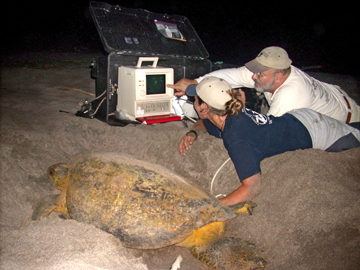Purdue Profiles: Frank Paladino

Frank Paladino, the Jack W. Schrey Distinguished Professor of Biology at Indiana University-Purdue University Fort Wayne, and Gabriella Blanco, a Ph.D. student, conduct an ovary ultrasound on a green sea turtle in Costa Rica. (Photo provided)
Frank Paladino, the Jack W. Schrey Distinguished Professor of Biology at Indiana University-Purdue University Fort Wayne, has been on National Geographic, NBC's "Today" show, PBS and Discovery Channel shining light on the migration and physiology of sea turtles and other large reptiles.
Although Indiana does not seem the most likely place to study marine reptiles, Paladino has more than 25 years of experience leading expeditions to Costa Rica, South Africa and India to study endangered leatherback sea turtles.
How did you become interested in sea turtles and their conservation?
I was born along the East Coast and grew up on the South Shore of Long Island, N.Y., so I gained an appreciation for nature, marine environments and marine animals. When Archie Carr, a famous naturalist from University of Florida, asked me to collaborate with him in Costa Rica at his Green Turtle Research Station, which is run by his nonprofit Caribbean Conservation Corporation, I just had to go. My colleague and mentor James Spotila also encouraged me to collaborate with him. Once I arrived in Costa Rica and worked with these ancient and magnificent beasts on a tropical beach, I was hooked.
Can you share a memorable moment from your time researching and working with leatherback sea turtles?
The first time I ever saw a leatherback in Tortuguero, Costa Rica. I had patrolled all night long in a downpour of a tropical rain forest and had been food for hundreds of mosquitoes and sand fleas all night. Exhausted, a volunteer and I sat on a tree trunk that had washed up along the beach. As he dozed off next to me, a 550-kilogram [1,212-pound], 8-foot-long leatherback turtle came out of the surf and began heading up the beach to construct her nest.
As the turtle walked next to us, she paused to breathe and woke the sleeping volunteer. He immediately asked, "What the heck is that?" With a smile for the first time that night, I told him that was what we had been searching for all night -- a leatherback the size of a Volkswagen Beetle.
It turned out to be a great night. For the first time we were able to measure the metabolism of an animal that evolved more than 20 million years before.
What is something about sea turtles that many people might not know?
They live to be 60 or more years old and don't mature to start laying eggs until they are 15 or 16. It's amazing that they start out as a 40-milligram hatchling that fits in the palm of a hand, and 16 years later they are over 300 kilograms and are often 7 to 8 feet long.
What is your favorite part of working in this field?
Engaging the students and seeing the enthusiasm generated by their quest for new knowledge always fires me up to get the funding and students to do it again the next year. It's the students and knowing that we're doing something important to help understand and preserve the earth's biodiversity that inspire us all to work hard and do whatever we can to save these magnificent animals and their oceanic and beach habitats.
You live and work as a professor in Indiana, but you study a marine animal. How is this possible?
It is great to be able to leave Indiana in the peak of nesting months -- October through March. During that time, I'm at the Goldring Marine Biological Laboratory in Playa Grande, Costa Rica, studying sea turtles. I get to miss a lot of the snow and ice, and the graduate and undergraduate students love being away from the Indiana cold during that time too.
Indiana is not the prime location to be a marine biologist, but students who know the literature will know that this is the place to come if they want to study leatherback turtles. I've had students come to work with me from South Africa, England, Spain, Argentina and Greece, as well as from all across the United States.
Why was it important to you to establish the Goldring Marine Biology Laboratory?
We created a nongovernmental organization -- The Leatherback Trust -- that owns and operates the station, which has become our base of operations for classes and researchers each year. We are able to leave and store much of our equipment there for use the following season. It is the only marine lab on the Pacific coast of Central America, and it has hosted researchers from Stanford University, University of Georgia, Virginia Tech, Virginia Institute of Marine Science, University of Florida, University of British Columbia, University of Southern California, Drexel University, University of North Carolina and faculty and students from Indiana University and Purdue.
